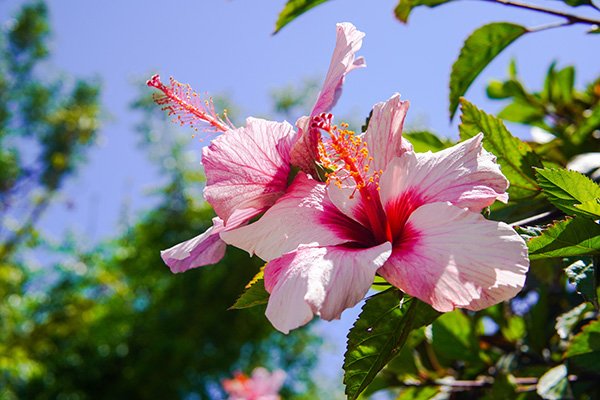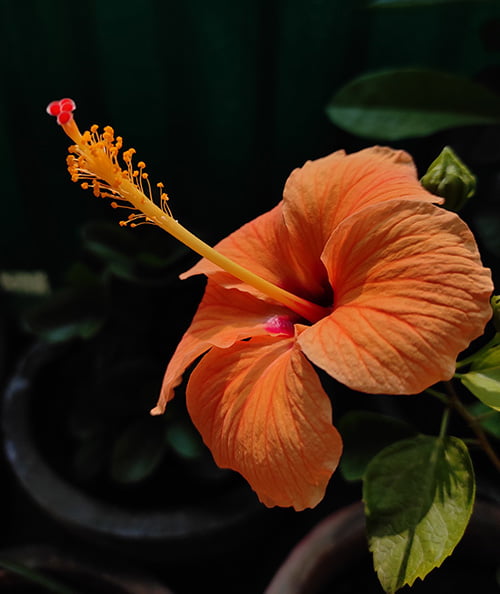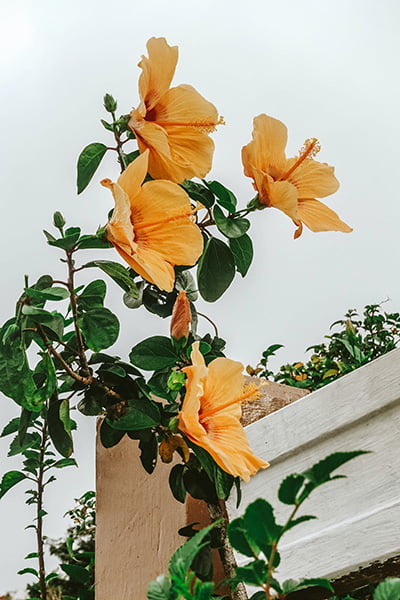Hibiscus flowers have long been a garden favorite due to their large, colorful blooms. There are many ways to enjoy hibiscus plants, but a particularly showstopping way is to grow a hibiscus plant as a tree! With a bit of forethought, you can keep your hibiscus growing year after year - and then a bit of purposeful pruning is all that is needed to encourage it to take on a tree-like growth habit!
All of this might appear overwhelming, but in reality, it's not! Growing a hibiscus tree is essentially the same as growing a typical hibiscus plant, and we're here to help you. Continue reading to discover how to care for hibiscus plants and train your hibiscus to become a tree!
Botanical Name
Common Name
Plant Type
Mature Size
Sun Requirement
Soil Type
Hardiness Zone
Pet Friendly
Hibiscus rosa-sinensis
Hibiscus Tree
Shrub or Small Tree
6 to 15 feet tall (depending on variety)
Full sun to partial shade
Well-drained, loamy soil
USDA zones 4-9
Yes
What Is a Hibiscus Tree?
It's unknown exactly where hibiscus plants first originated. There are hundreds of species of hibiscus from around the world. They grow in warm, tropical climates, and experts believe that the different species originated from China, India, Hawaii, and Madagascar.
Hibiscus is part of the Mallow family of plants and is characterized by its intensely colorful flowers. The trumpet-shaped flowers typically have at least five petals and a long, showy filament coming from its center. The vibrant blooms can be found in shades of red, pink, yellow, orange, white, and blue. These gorgeous flowers are particularly attractive to butterflies and hummingbirds.
In general, hibiscus species can be divided into two broad groups - tropical and perennial. They have a similar appearance and growth habit, although perennial hibiscus plants typically have larger flowers and lighter green leaves. The primary distinction between these two categories lies in their capacity to withstand colder temperatures. While all hibiscus plants are "tropical," perennial hibiscus plants can handle somewhat chillier temperatures than the specifically tropical hibiscus plants.
Because hibiscus plants prefer warm weather, they are often grown as container plants in the United States. This allows them to be brought indoors when the temperature requires it. When used for container gardening, you can expect your hibiscus plant to reach heights of 5 to 8 feet.

Image Source: Pexels
Hibiscus Tree Varieties
Hibiscus rosa-sinensis
Also known as the Chinese hibiscus, this stands as one of the most prevalent and extensively grown species of hibiscus. Hibiscus rosa sinensis comes in a vast array of flower colors, including red, pink, orange, yellow, white, and combinations. There are both single and double-flowered varieties.
Hibiscus syriacus
Commonly known as the Rose of Sharon, this hibiscus species is deciduous and tends to grow as a shrub rather than a tree. It produces attractive, large, single, or double flowers in various colors.
Hibiscus mutabilis
Also called the Confederate rose, this hibiscus species is known for its unique ability to change flower colors as they age. The flowers start as white or pale pink and gradually darken to deep pink or red over a day or two.
Hibiscus coccineus
This species, commonly called the Texas star hibiscus or scarlet hibiscus, produces large, deep-red flowers with prominent stamens. Recognized for its striking visual appeal, this variety has the potential to attain considerable height as it grows.
Hibiscus heterophyllus
Native to Hawaii, this species is often called the Native Hawaiian hibiscus. It features large, colorful hibiscus flowers and is known for its vibrant cultural significance.
Hibiscus schizopetalus
Sometimes known as the Japanese lantern hibiscus, this species has unique pendulous flowers with fringed petals that resemble hanging lanterns.
Hibiscus sabdariffa
Referred to as roselle or sorrel, this hibiscus is cultivated for its edible calyxes, used in creating teas, jams, and various culinary delicacies. It has a tangy flavor.
Hibiscus acetosella
This hibiscus is often referred to as the African rosemallow or cranberry hibiscus. It's grown for its stunning dark red foliage and produces red or pink hibiscus flowers. It's commonly used as an ornamental plant.
Hibiscus Tree Care Requirements
Light
This tropical plant needs lots of suns! Select a location for your hibiscus plant where it can bask in a minimum of 8 hours of direct sunlight. However, if your afternoon sun is particularly oppressive, consider moving your tree to a location that receives afternoon shade. Hibiscus will grow fine in partial shade locations as long as the sun it receives is very bright.
When cultivating indoor hibiscus plants, position them close to a south-facing window to ensure they receive abundant sunlight. If natural sunlight is inadequate, particularly during the darker months of the year, contemplate utilizing artificial grow lights.
When you're planting hibiscus plants in outdoor settings, opt for a spot that enjoys ample sunlight throughout the entire day. Steer clear of areas with excessive shade caused by trees or buildings, as this can result in diminished flowering and overall growth.
Water
Hibiscus plants thrive in soil that is well-draining, enabling excess water to move away from their roots. Soil with inadequate drainage can result in root rot and other complications. Enhance soil drainage by incorporating organic matter such as compost into the soil.
Hibiscus trees demand reliable and frequent watering, particularly during their active growth period, which usually spans spring to fall. Provide water when the soil's upper inch (2.5 cm) becomes dry to the touch. Gauge the moisture level by inserting your finger into the soil.
The watering frequency will be contingent upon variables like climate, temperature, humidity, and soil type. You might need to water more often during hot and dry periods, while during cooler and rainy periods, less frequent watering may be necessary.
During watering, ensure thorough saturation of the soil. This stimulates the roots to extend deeply into the ground, enhancing the tree's resilience against drought. Shallow watering can lead to limited root growth, increasing the tree's susceptibility to water-related stress.
While hibiscus trees need regular watering, it's important not to overwater them. Excessively wet soil can trigger root rot and other fungal ailments. To prevent overwatering, confirm that the soil possesses adequate drainage and permit the upper inch or so of the soil to become dry before the next watering.

Edit your caption text here
Temperature
You will need to be mindful of the temperature when growing hibiscus trees and you will need to know what type of hibiscus plant you have. Tropical hibiscus plants can only survive outdoors in USDA Hardiness Zones 10-12. Perennial hibiscus, on the other hand, can survive winters in Zones 4-9.
As soon as the overnight temperatures dip to 50 degrees Fahrenheit or below, you will need to bring your hibiscus indoors. For many climates, this necessitates growing hibiscus in a pot that can be moved.
Once indoors, take care not to place your tropical hibiscus plant near locations that might experience temperature swings - such as drafty windows or doors, near heating and cooling vents, or by entryways.
Soil
While this plant isn't picky about soil, you will enjoy thicker foliage and more abundant hibiscus flowers if you plant your tree in rich and well-draining soil. You can make your own potting mix by combining two parts of standard potting soil with one part of perlite or vermiculite (for drainage) and two parts of peat moss (for moisture retention).
Hibiscus trees flourish in soil that is slightly acidic to neutral, displaying a pH range of approximately 6.0 to 7.0. You can test the pH of your soil using a soil testing kit to ensure it falls within this range. Adjusting the pH with amendments might be necessary if your soil is too alkaline.
Enriching the soil with organic matter provides advantages for hibiscus trees. Materials like compost or well-rotted manure enhance soil composition, moisture retention, and nutrient accessibility. Blend organic matter into the soil before planting and utilize it as a top layer during the growth period.
For those cultivating hibiscus trees in containers, opt for a premium potting mix designed for tropical plants or flowering shrubs. Such mixes typically possess excellent drainage characteristics and maintain moist soil without becoming overly saturated.
Fertilization
Fertilization of hibiscus trees is recommended throughout their active growth period, generally spanning from spring to early fall. Avoid fertilizing during the dormant winter months. Generally, you can start fertilizing when new growth emerges in the spring.
Fertilize hibiscus trees every 4 to 6 weeks during the growing season. Nonetheless, the frequency could differ based on the fertilizer type and the specific requirements of your tree. It's crucial to adhere to the instructions on the fertilizer packaging, ensuring accurate application rates and schedules.
Hibiscus trees thrive with a well-balanced fertilizer containing approximately equal proportions of nitrogen (N), phosphorus (P), and potassium (K), along with essential micronutrients. Seek out fertilizers labeled as "complete" or "all-purpose" with an N-P-K ratio of approximately 10-10-10 or similar. Additionally, a fertilizer specifically formulated for flowering plants can be beneficial to encourage blooming.
Pruning
In order to grow hibiscus as a tree, you need to prune it regularly and best in early spring. Not only will this help your hibiscus plant to grow upright and woody, but it also encourages bushier foliage and more abundant blooms! Pinch away radial branches aggressively when the hibiscus plant is small to help the plant form a center trunk. You need to establish 3 to 4 main branches. Choose the most upright branches available.
At the top, where you want the leaves and flowers to be concentrated, pinch off branches just above a bud or leaf node. New growth will branch out from this location, helping to create density.
Propagation
Hibiscus plants can be propagated through softwood cuttings, hardwood cuttings, and air layering. The easiest method for home gardeners is softwood cuttings.
Cuttings
- Use clean pruning shears to cut away a length of stem that is 5 inches long. This should be from an area of new growth with the softest wood.
- Eliminate the lower leaves from the cutting and immerse the tip in rooting hormone powder.
- Position the cutting into a small pot, then shield the pot with a plastic bag to retain moisture and position it on a sunny windowsill. Remember to keep the soil consistently damp!
- You should see roots develop in a month, and your cutting is ready to be transplanted.
Seeds
- Collect seeds from the parent hibiscus tree or purchase fresh hibiscus seeds.
- Fill small pots with a seed-starting mixture. Dampen the mixture with water.
- Sow the hibiscus seeds at a depth of approximately ¼ inch within the seed starting mix. It's possible to plant multiple seeds in each tray or pot.
- Place plastic wrap or transparent plastic covers over the trays or pots to establish a humid environment, facilitating seed germination.
- Place the trays or pots in a warm location with indirect light. Maintain the soil consistently damp, avoiding excessive waterlogging.
- Hibiscus seeds usually germinate within a couple of weeks to a few months. After the seedlings develop a few leaves and gain sufficient strength, they can be relocated into separate pots. As the seedlings mature further and demonstrate robustness, transfer them into larger pots or directly into the garden.

Image Source: Unsplash
Common Problems And Troubleshoots
Common Pests
Even a hardy hibiscus will sometimes have an infestation of the typical garden pests. Hibiscus commonly faces challenges with whiteflies, aphids, mealybugs, thrips, scale insects, and spider mites. They all attack the plant in different ways but can be remedied by removing as many as possible by hand and then treating the plant with neem oil or insecticidal soap.
Yellowing Leaves
Yellowing leaves with green veins can indicate iron deficiency (chlorosis) caused by alkaline soil or poor nutrient uptake. Apply a fertilizer designed for plants that prefer acidic conditions, or consider utilizing iron chelate supplements to rectify the deficiency. Check and adjust the soil pH if it's too alkaline.
Dropping Leaves
Hibiscus trees could shed leaves due to excessive watering, insufficient watering, or environmental strain. Ensure appropriate watering techniques by permitting the top inch of soil to dry before the next watering. Avoid waterlogged soil. Maintain a consistent watering schedule and provide appropriate shade during hot periods.
Fungal Diseases
Fungal diseases such as powdery mildew, rust, and leaf spot can affect hibiscus trees, causing discolored or spotted leaves. Improve the air circulation around the plant by trimming dense growth. Prevent moisture accumulation on leaves by refraining from overhead watering. Use fungicides labeled for the specific disease if necessary.
Lack of Flowering
If your hibiscus tree isn't flowering, it could be due to inadequate sunlight, nutrient deficiencies, pruning at the wrong time, or environmental stress. Ensure your hibiscus obtains a minimum of 6 to 8 hours of direct sunlight every day. Provide proper fertilization with a balanced fertilizer formulated for flowering plants. Avoid heavy pruning during the flowering season.
Bud Drop
Buds dropping before they open can be caused by fluctuations in temperature, insufficient water, or pest activity. Maintain a regular watering routine, steering clear of both excessive watering and insufficient watering. Protect your hibiscus from sudden temperature changes. Inspect for pests and take appropriate measures if found.
Wind and Sun Damage
Strong winds can cause leaf damage, while intense sunlight can scorch leaves. Provide windbreaks or move potted hibiscus trees to a more sheltered location during windy periods. Offer a degree of shade during the peak heat hours to shield against sunburn.
Root Rot
Excessive soil moisture can result in root rot, leading to wilting and the deterioration of the plant's health. Enhance soil drainage by employing well-draining soil and containers equipped with drainage holes. Water the plant when the upper inch of soil becomes dry and prevent waterlogging.
Powdery Mildew
Powdery mildew is a fungal disease that affects a wide range of plants, including hibiscus. It appears as a white or grayish powdery substance on the leaves, stems, and sometimes even flowers of plants. Enhance the air circulation around the plant, refrain from overhead watering, and make certain there's sufficient spacing. Use fungicidal sprays containing sulfur or other mildew-control agents.
Is Hibiscus Pet Friendly?
The answer to this question will depend on the species of hibiscus. Some species, such as Rose Of Sharon (Hibiscus syriacus), are toxic to dogs and cats and can induce vomiting, diarrhea, and mouth blisters. Other types are perfectly safe for pets to ingest accidentally. To be cautious, keeping your pet away from hibiscus plants may be the best.
